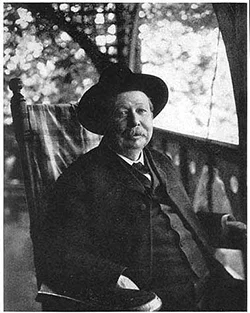The Rabbit and the Ram
Scroll down
An evening in late summer, not far from Eatenton, Georgia, in the last quarter of the 19th century.
Mr. Benjamin Ram sits in front of his cabin which stands where a newly-cleared field meets a virgin
forest of Georgia pine.
Mr. Benjamin Ram … Paul Kreshka
Br’er Rabbit … Ilene Kreshka
Program Music
- Quills* “Plantation Play Song” original tune call:
Putnam County, 1856,
collected by Joel Chandler in UNCLE REMUS HIS SONGS AND SAYINGSclose*The quills are an early American folk instrument. They are also known as pan pipes, an ancient instrument that is found in numerous cultures on most continents. - Uncredited slave song, pre-emancipation**
close**If your house catch fire/Ain’t no water round/Throw your trunk out the window/Let her burn on down/I worked for Mr. Charley/Worked for Mr. Blair/I wouldn’t leave the brother/For to go nowhere
- “A Song of the Mole” Putnam County, 1862,
collected by Joel Chandler Harris in UNCLE REMUS AND HIS FRIENDS***close***The jaybird hunt the sparrow nest/The bee martin sail all around/The squirrel, he holler from the top of the tree/Mr. Mole he stay in the ground/He hide and he stay ‘til the dark drop down/Mr. Mole, he stay in the ground/The wippoorwill holler from ‘cross the fence/He got no peace of mind/Mr. Mole he grabble and he dig ‘til he land/Underneath the sweet-tater vine/He land down there where no sun ain’t shine/Underneath the sweet-tater vine/The sparrow-hawk whet his bill on the rail/Oh, ladies, listen to me!/Mr. Mole he handle his two little spade/Down there where no eye can see/He dig so far and he dig so free/Down there where no eye can see - “Cluck Old Hen” Traditional American folk song, dates, origins unknown****
close****My old hen is a good old hen/She lays eggs for the railroad men/Sometimes one, sometimes two/Sometimes enough for the whole dang crew/Cluck old hen, cluck and sing/Ain’t seen an egg since way last spring/Cluck old hen, cluck and squall/Ain’t seen an egg since way last fall/Old hen cackle, cackle in the lot/Next time she cackle, she cackle in the pot
- “Cripple Creek” Traditional American banjo tune, dates, origins unknown
- “Walk-A-Chalk” around Sapelo, Georgia Coast
after lyric collected by Joel Chandler Harris UNCLE REMUS AND HIS FRIENDS Lyric IX - Patting *****
close*****American slaves were prevented from building and playing drums, so they used their own bodies as a percussion instrument.
- “Negro Love Song” Ibid Lyric XI
- Uncredited lyric of ca. 1700,
collected by W.E.B. DuBois in THE SOULS OF BLACK FOLK - Reprise “Plantation Play Song”
The Author
Joel Chandler Harris (9 December 1848 – 3 July 1908) was a journalist and fiction writer, as well as a folklorist. His enduring fame rests on his collection of tales, collected from freed slaves after the Civil War.
Harris was born in Eatenton, Georgia. His mother, Mary Ann Harris, was an Irish immigrant. His father abandoned mother and child shortly after his son’s birth. The father’s identity remains unknown. The illegitimate boy was named Joel after his mother’s attending physician; Chandler was the name of his mother’s uncle. Mary Harris worked as a seamstress and helped neighbors with their gardening to support herself and her son. When he was fourteen, Harris quit school and went to work as a printer’s apprentice for a local newspaper, “The Countryman”, where the owner, Joseph Addison Turner, published the young man’s poems and reviews and further allowed him to use the library at his plantation. While at Turnwold plantation, Harris spent much of his free time in the slave quarters. The fatherless, illegitimate child of an Irish immigrant felt less an outcast among them, and grew close to the slaves, listening by the hour to their stories, poetry and songs. The African-American animal tales they told became the models for the Uncle Remus tales; two of the storytellers, Uncle George Terrell and Old Harbert, are said to be the models for Uncle Remus himself.

Harris grew in reputation as a writer. He moved to Atlanta in 1876. It was not long after that he began writing the Uncle Remus stories as a newspaper serial. He was approached by the publisher D. Appleton and Company to compile the stories for a book, “Uncle Remus; His Songs and Sayings.” In the following period, Chandler was widely published in both magazines and as a novelist. In 1905 he was elected to the American Academy of Arts and Letters. Upon his death in 1908, the New York Times Book Review wrote, “Uncle Remus cannot die. Joel Chandler Harris has departed this life at the age of sixty…but his best creation will live forever.”

List of Uncle Remus books:
- UNCLE REMUS: HIS SONGS AND SAYINGS (1880)
- NIGHTS WITH UNCLE REMUS (1883)
- UNCLE REMUS AND HIS FRIENDS (1892)
- THE TAR BABY AND OTHER RHYMES OF UNCLE REMUS (1904)
- TOLD BY UNCLE REMUS: NEW STORIES OF THE OLD PLANTATION (1905)
- UNCLE REMUS AND BRER RABBIT (1907)
- (Posthumous) UNCLE REMUS AND THE LITTLE BOY (1910)
- SEVEN TALES OF UNCLE REMUS (1948)
Who is Br’er Rabbit?
Aesop and Uncle Remus had taught us that comedy is a disguised form of philosophical instruction; and especially when it allows us to glimpse the animal instincts lying beneath the surface of our civilized affectations.
The central character of the Remus stories is a trickster hero, Br’er (Brother) Rabbit. The trickster is a universally loved character, and found in myths and stories through the ages. But who is he? And why does he exert such fascination on adults and children alike?
The myth of the hero is the story of a godlike character which stands as a symbol for us – for the god-like identity that supports our own psyches with the scope and strength that our personal egos lack. According to the Swiss psychologist C.G. Jung, the hero journey to find the whole self is divided into stages; the first stage in the journey corresponds to the earliest period of our lives, dominated by basic needs and heedless freedom. The Br’er Rabbit stories express this part of life which is common to all.
The plantation slaves’ Br’er fables are derived directly from the Yoruba tales of “Hare” from Southwestern Nigeria, possibly mixed with some Native American influences. The success of these animal fables introduced the American South to readers all over the world and the Remus stories have influenced British children’s authors such as Kipling, Milne, Potter and Blyton as well as modernist writers such as Pound, Eliot, Joyce and Faulkner.
Who is Benjamin Ram?
The ram is a classic “sun animal” and is associated with power and light. In our story, Mr. Benjamin Ram is also identified as a tiller of the soil, of “new ground”, and so he is both ground-breaker and nourisher.
The “Old Musician” who plays alone in a lonely landscape is a symbol of spiritual generation and one of the many mythic guises of the Creator.
We can also note that Mr. Benjamin Ram lives all by his own-alone self way out in the middle of a big new (newly-cleared) ground and he works, lives and plays his music at a borderland where untouched nature and the cultivation of civilization meet.
Biographies
PAUL KRESHKA
an Austrian-American singer, actor and musician. He began playing various instruments as a child growing up in California. He studied acting at the Juilliard School in New York, toured nationally playing Shakespeare, and was a member of the Berkeley Shakespeare Festival. He was the original percussionist on and off Broadway in the musical “Strider” and appeared in Joe Papp’s “Shakespeare in the Park”. In Austria he is known as a singer of various popular styles and with his band “Five In Love” toured swing music internationally as well as appearing in Austria. Together with his wife, he tours American-themed historical cultural shows to U.S.-related venues, such as American Spaces and American Corners – initiatives of the U.S. government in partnership with host countries’ local institutions – most recently “Cowboy Days” which features music from the Smithsonian Institute’s John Lomax folk music collection, with authentic spoken text from the post-Civil War cattle drives, as well as a section on the development of black music from its rhythmic beginnings, and a program based on the work and life of Emily Dickinson, “The Belle of Amherst” with music of the period. The programs are also presented for American Studies programs in universities internationally.
ILENE KRESHKA
originally trained as a ballet dancer, comes from New York. Since coming to Austria she has appeared in many plays including “The Belle of Amherst”, a one- woman show about the life and work of Emily Dickinson. She has worked in films, television and commercials. Together with her husband, she tours American-themed historical cultural shows to U.S.-related venues, such as American Spaces and American Corners – initiatives of the U.S. government in partnership with host countries’ local institutions. The programs are also presented for American Studies programs in universities internationally. The programs have toured in many countries, including Austria, Germany, Hungary, Poland, Slovakia, Estonia, Latvia, Lithuania and Taiwan.
Contacts
For booking and further information please contact:
Paul Kreshkapaulkkreshka2002@yahoo.com
(tel.) +43 (0) 676 970 35 45
The production has no particular space requirements and is suitable for small spaces in conference rooms, libraries, etc., as well as larger venues.
The program is free for cultural and charitable events, made possible by a grant from Transnet Contracts Ltd.
Website audio tracks recorded at Studio Art & Design, Saalfelden, Austria.
Website design by
OBINET